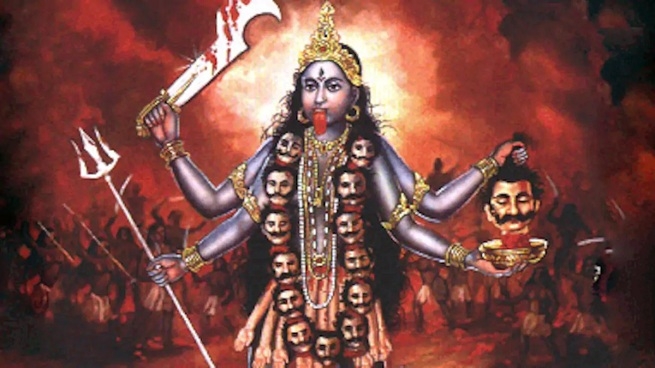Kali - The Goddess of Yogic Transformation
25 Mar 2020 10:38:51

By Rajendra Diwe :
Chaitra Navratri starts on March 25. It is a time to remember Dasha Mahavidya, ‘the ten great knowledge’ during the nine days
NAVARATRI is a festival of nine nights of worship of Goddesses. There are three main forms of Goddesses like Mahalaxmi, Mahakali and Mahasaraswati. Three out of Navratri (nine nights) are dedicated to each form of Goddess. In Tantra Yoga, worship of Mahakali is very important. The ten forms of Mahakali are known as Dasha Mahavidya. In India, though the worship of Dasha Mahavidya is not much popular, in Western countries many scholars, scientists and researchers are attracted towards these ten forms of Goddess Mahakali.
Dr David Frawley, also very popular as Pandit Vamadev Shashtri is one of the most important scholars of Ayurveda and Vedic Science, says, “Hindu deities represent the Divine consciousness functioning on all levels of the universe, both outward and inward. They represent the various principles, energies and faculties which make up this great universe, manifest and unmanifest. The Goddess, who represents creation on all levels, possesses this same diversity, which is expressed through her Ten Wisdom Forms (Dasha Mahavidya) and their different functions.
Dasha Mahavidya means the ‘Ten Great Knowledges’. Georg Feuerstein states, “They reveal the inner workings of both the universe and the psyche, once the veil of appearances is pulled down. They represent the deeper truths of life hidden behind our attachment to the outer form of things. Their messages are sometimes inspiring and sometimes frightening because they represent life itself, but they are always instructive to those who are looking for something beyond the ordinary realm.”
Dr Frawley elaborates on the worship of Kali by Ramkrishna Paramhansa and says, “As the chosen Deity worshipped by Paramahansa Ramakrishna, one of the most well-known modern teachers within the Hindu tradition, Kali is one of the most commonly known of Hindu Goddesses, but still not well understood. Yet much of what we admire in Ramakrishna – his love, bliss, and universal spirit – is Kali’s gift to us through him. Through him Kali has already delivered us her message for the modern age.” He elaborates, “Time is life. Life is our movement in time.
Through our own life-force or Prana we experience time. Kali as time is Prana or the life-force. Kali or the Divine Mother is our life. She is the secret power behind the working of our bodily systems and vital energy. Only through her do we live, and it is her intelligence that gives such a marvelous order to the body. Kali is the love that exists at the heart of life, which is the immortal life that endures through both life and death. Maintaining the awareness of the eternal nature of life through the cycles of birth and death is another one of her meditational approaches. Another famous indologist David R Kinsley, in his book “Tantric Visions of the Divine Feminine: The Ten Mahavidyas” mentions, “Kali might be thought of as a symbol of ultimate reality, an embodiment of the highest truths.
By interpreting her features and habits allegorically and imaginatively, which is a widely accepted and practiced approach to understanding her, the adept can glimpse secrets that point to certain central truths of the Hindu tradition. In this latter approach, Kali’s dramatic, often offensive, always shocking appearance is not necessarily to be taken literally. Her real meaning is not obvious to the uninitiated; it reveals itself only to imaginative and spiritually sensitive interpretation.”
